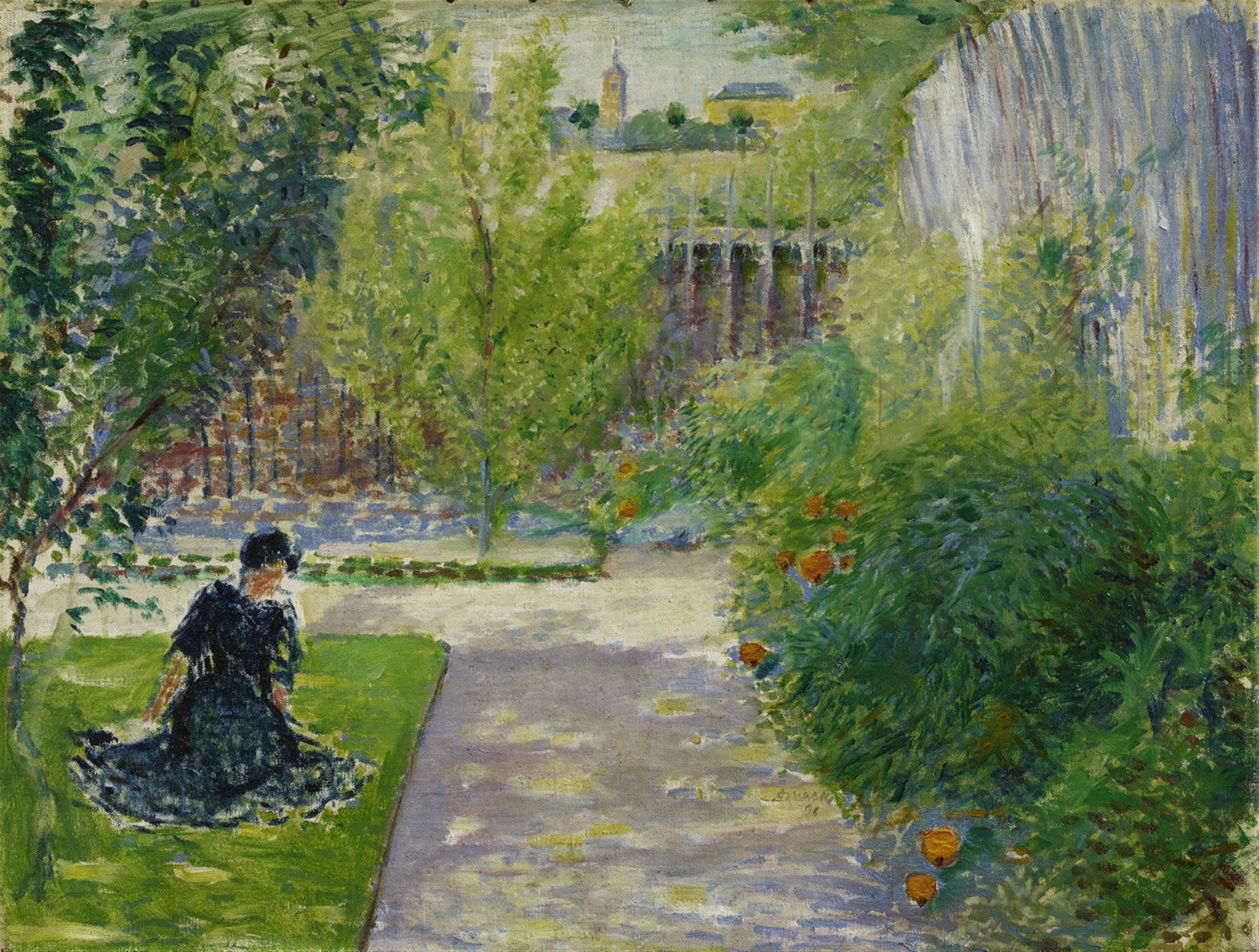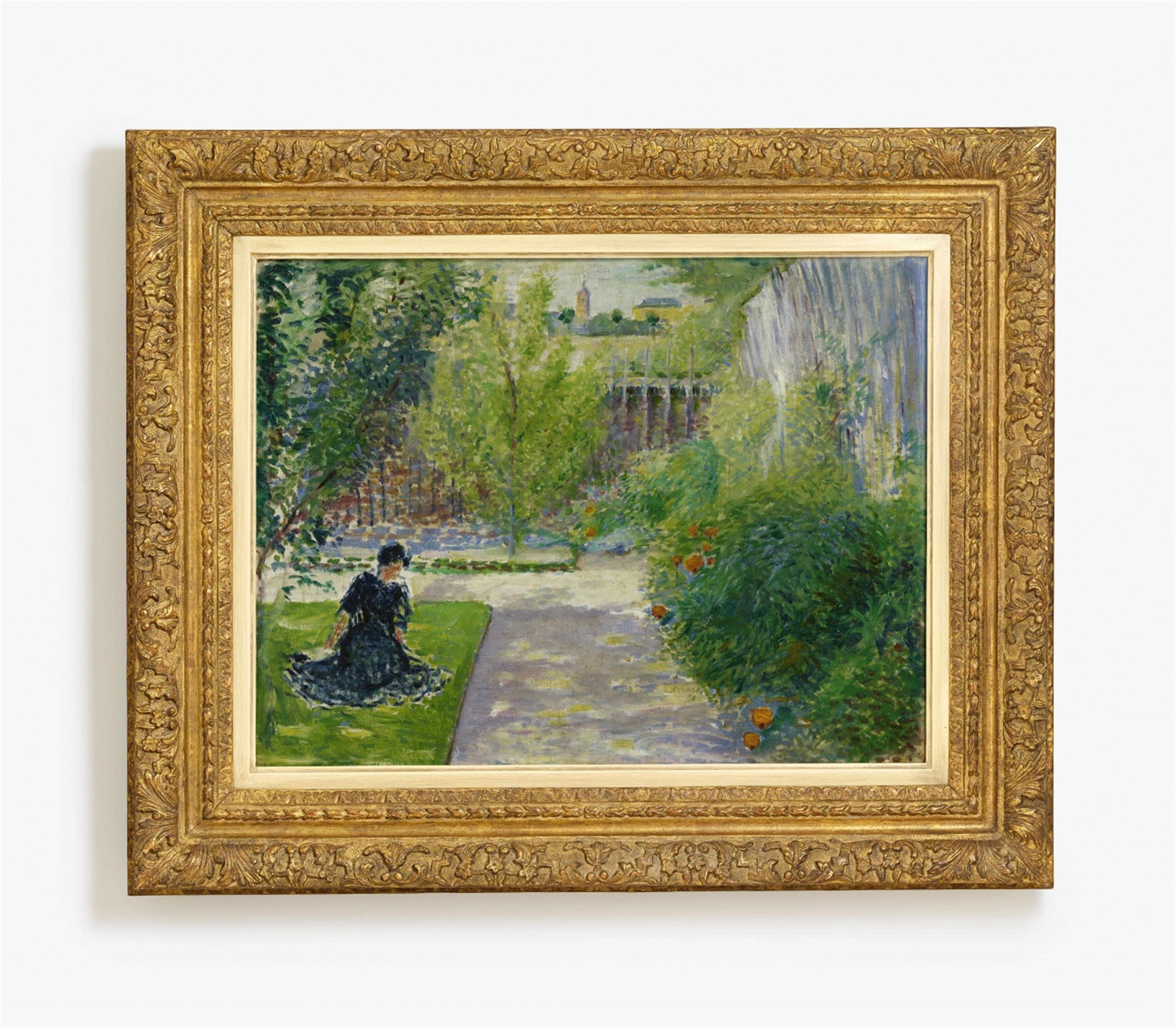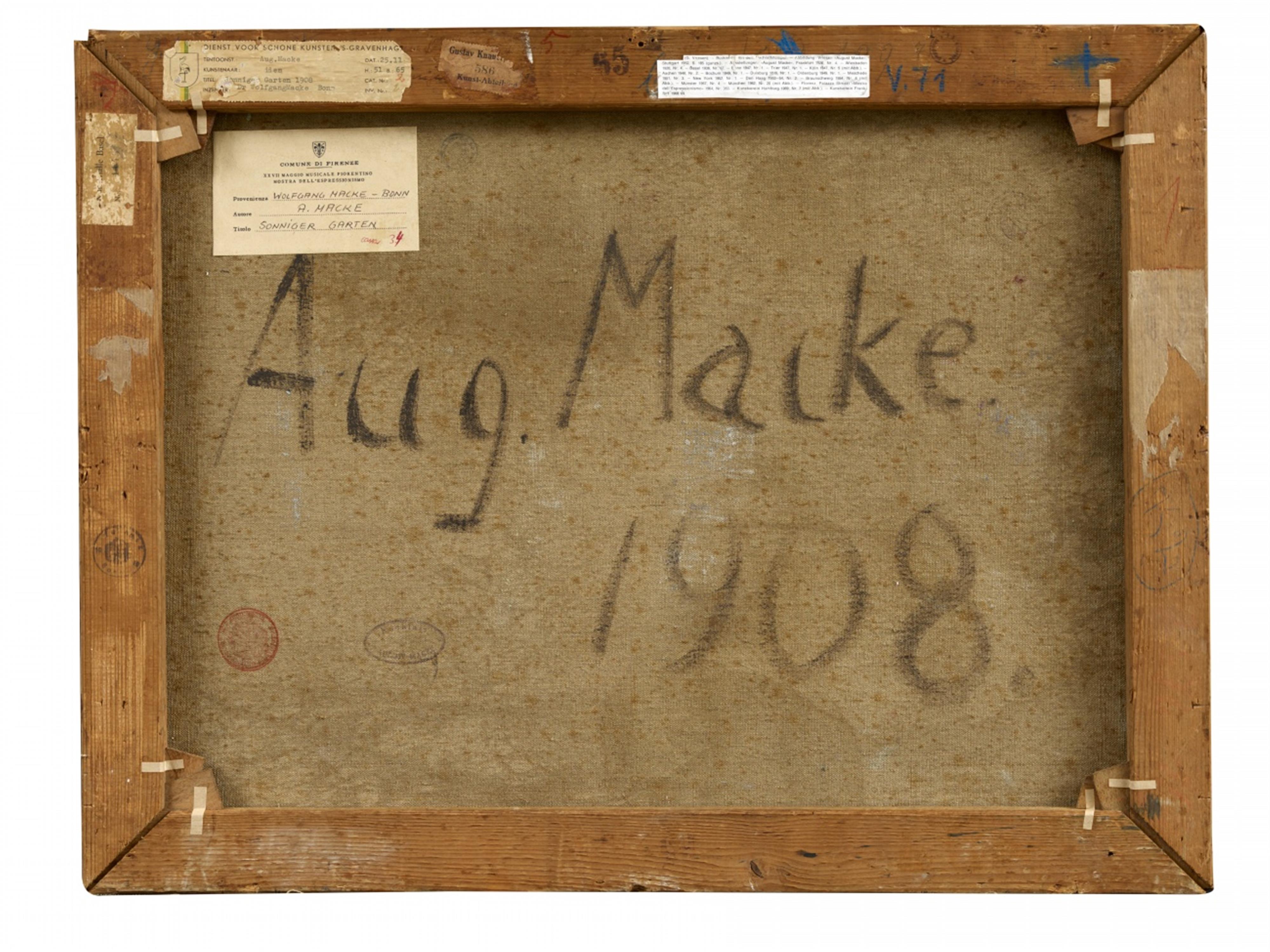August Macke
Sonniger Garten
1908
Oil on canvas 50.8 x 66 cm Framed. Signed 'A Macke 08' (joined) in grey in lower area of picture to right of centre. Verso signed and dated 'Aug. Macke. 1908.' in black and with oval stamp "Nachlass AUGUST MACKE" (Lugt 1775b) twice on canvas and right stretcher bar.
“Sonniger Garten” is a key painting from an important phase in August Macke's early career. It was created in 1908, which was an eventful and seminal year for the artist. In the spring he travelled through Italy with his future fiancée Elisabeth Gerhardt and her family, occupying himself with early and high Renaissance art. In the summer he set out on his second journey to Paris, together with Elisabeth and her uncle Bernhard Koehler, who had become an important patron of Macke. There he had the opportunity to see outstanding works by the pointillists and impressionists in the galleries of Bernheim-Jeune, Durand-Ruel and Vollard. He had been heavily influenced by French artists since his first journey to Paris in 1907 - Paul Cézanne, in particular, had become a role model whom he admired to a fault. Macke sought to capture the feeling of modern life in its colourful diversity and dynamism. In 1907 he wrote to Elisabeth: “In the dead corners of olden times I no longer find life, our life, this colourful glow in our sky, buildings and boulevards” (cited in: August Macke ganz privat, exh. cat. Kunsthaus Stade/Städt. Museen Freiburg/August Macke Haus Bonn 2009-2011, p. 38).
The impressionistic, atmospherically delicate style of painting he saw in Paris made its way into his work, and our picture provides a striking testament to this. It shows the garden of the Gerhardt family on a bright summer day. Our gaze is guided over the high fence surrounding the carefully tended garden and past the rustic-looking area around it to the elevated architectural ensemble of the mental hospital then known as the “Königliche Universitätsklinik für Psychische- und Nervenkranke” and now known as the “LVR-Klinik”.
The painting is veritably permeated with light; the leaves of the trees and bushes cast shadows filled with delicate colours. The woman seated on the lawn in a dark dress and hat is surely Elisabeth Gerhardt. Macke has laid out her figure in a transparent structure consisting of open hatching, thus simultaneously capturing the delicate flecks of light described on her form by the sunlight.
The artist became engaged to Elisabeth on Christmas in 1908 after having to report for his year of military service in October of that busy year. Macke had already been welcome to come and go as he pleased at the house of the hospitable Gerhardt family long before their engagement, and the family enjoyed their garden as a place to spend time together. The couple were married in October 1909. In 1910, when they returned to Bonn after their long stay by the Tegernsee, where their son Walter was born, the Gerhardts let the young family use a house on their estates - today's August Macke House - as their home and studio. The family garden would also continue to play an important role in the life and work of August Macke, as demonstrated by a series of garden pictures created in 1911/1912.
The outstanding work offered here has been assigned special significance as one of the earliest garden pictures and has been prominently exhibited many times.
Catalogue Raisonné
Heiderich 95, Vriesen 71
Provenance
Estate of the artist; Private possession (1957); Hauswedell & Nolte Hamburg, Auktion 6 - 8 June 1973, lot 1133; Private possession; Christie's London, German & Austrian Art, 17 October 2000, lot 36; Collection Corboud, long-term loan at Wallraf-Richartz-Museum - Fondation Corboud, Cologne (frame label verso)
Literature
Gustav Vriesen, Der Maler August Macke, in: Westfalen, Hefte für Geschichte, Kunst und Volkskunde, vol. 30, no.1, Münster 1952, p. 37/49, with ill. no. 20, p. 35; Walter Holzhausen, August Macke, Munich 1956, p. 13; Peter Selz, German Expressionist Painting, Berkeley/Los Angeles/London 1957, with ill. no. 86, p. 207; Wolfgang Macke, August Mackes Bonner Zeit, in: Bonner Geschichtsblätter, vol. 21, Bonn 1967, p. 165; Ernst-Gerhard Güse, August Macke, der Impressionismus und die Fauves. Ein Beitrag zu Mackes Rezeption französischer Malerei, in exh. cat. August Macke, Gemälde, Aquarelle, Zeichnungen, Westfälisches Landesmuseum für Kunst- und Kulturgeschichte Münster/Städtisches Kunstmuseum Bonn/Städtische Galerie im Lenbachhaus Munich 1986/1987, p. 27 f. with ill. no. 13; Andreas Pohlmann, August Macke und Bonn. Eine Stadt im Wandel, künstlerischer Anschauung, in: Schriftenreihe Verein August Macke Haus Bonn no. 7, Bonn 1993 with ill. 18, p. 50; Exh. cat. August Macke: Blickfänge in und um sein Bonner Haus, August Macke Haus Bonn 2001, cat. no. 52 with ill. p. 159
Exhibitions
Frankfurt 1920 (Kunstverein), Gedächtnis-Ausstellung August Macke, cat. no. 4; Wiesbaden 1920 (Neues Museum & Nassauischer Kunstverein), Gedächtnis-Ausstellung August Macke, cat. no. 4; Basel 1936 (Kunsthalle), Paula Modersohn-Becker – August Macke, cat. no. 67 (exhibition label verso); Bonn 1947 (Die Brücke), August Macke, cat. no. 1; Cologne 1947 (Museen der Stadt Köln in der Alten Universität), August Macke, Gedächtnisausstellung, cat. no. 5; Trier 1947 (Werkschule), August Macke – Gedächtnisausstellung, cat. no. 1; Aachen 1948 (Suermondt-Museum), Gedächtnisausstellung des Museumsvereins, cat. no. 2; Oldenburg 1948/1949 (Kunstverein), August Macke, Gemälde, Aquarelle und Zeichnungen, cat. no. 1; Bochum 1949 (Richard-Baltz-Haus), August Macke Gedächtnisausstellung, cat. no. 1; Dortmund 1949 (Museum am Ostwall), August Macke Gedächtnisausstellung, cat. no. 1; Duisburg 1949 (Städtisches Kunstmuseum), August Macke, cat. no. 1; Hanover 1951 (Kunstverein), Blumen und Gärten in der Malerei, cat. no. 171; Meschede 1951 (Landratsamt), August Macke, Gedächtnis-Ausstellung, cat. no. 3; New York 1952 (Fine Arts Associates, Otto M. Gerson), August Macke, cat. no. 1; The Hague 1953/1954 (Gemeentemuseum), August Macke, cat. no. 2 (exhibition label verso); Braunschweig 1954 (Kunstverein), August Macke, cat. no. 6 with ill.; Münster 1957 (Westfälischer Kunstverein/Westfälische Wilhelms-Universität/Westfälisches Landesmuseum für Kunst- und Kulturgeschichte), August Macke – Gedenkausstellung zum 70. Geburtstag, cat. no. 4; Munich 1962 (Städtische Galerie im Lenbachhaus), August Macke, cat. no. 23 with ill.; Florence 1964 (XXVII Maggio Musicale Fiorentino, Palazzo Strozzi), L’Espressionismo pittura scultura architettura, cat. no. 353 (exhibition label verso); Hamburg/Frankfurt 1968/1969 (Kunstverein/Kunstverein), August Macke, Gemälde, Aquarelle, Zeichnungen, cat. no. 7 with ill. 31; Cologne 2001 (Wallraf-Richartz-Museum – Fondation Corboud), Miracle de la couleur, p. 452; Rotterdam 2003 (Kunsthal), Miracle de la couleur – Meesterwerken uit de Fondation Corboud (exhibition label verso)






